By Pam Martens and Russ Martens: December 8, 2020 ~
There has been a lot of bullish talk about the Dow Jones Industrial Average reaching 30,000 for the first time in history. But the underpinnings of the bellwether Dow index look a lot less rosy.
Replacing three of the Dow Jones Industrial Average stocks on August 31 looked like a desperate move by S&P Dow Jones Indices, the folks that oversee that stock index. One of the stocks replaced, Exxon Mobil, had been a Dow component for 92 years, joining the Dow in 1928 under the name Standard Oil of New Jersey. Exxon was replaced with Salesforce, a company that only went public in 2004. Salesforce describes itself as a “customer relationship management platform,” explaining that “We help your marketing, sales, commerce, service and IT teams work as one from anywhere — so you can keep your customers happy everywhere.” If that sounds a little nebulous to you, it should. But the stock price has been on a rip for the past four years so Wall Street loves it.
The two other stocks in the Dow that were replaced on August 31 were the pharmaceutical giant, Pfizer, replaced with biotech company Amgen; and Raytheon Technologies, replaced by Honeywell International.
What might have prompted that radical shakeup in the Dow in August? As of August 19, five days before the announcement was released to the press, two-thirds of the 30 Dow components were in the red for the year.
We decided to take a look at where things would stand today if the August 31 shakeup in the Dow had not happened. It turns out that 13 of the pre-August 31 Dow 30 stocks, a remarkable 43 percent, are in the red year-to-date.
The declines are as follows, using the closing prices on December 31, 2019 through the closing prices on Monday, December 7, 2020. (The returns are based strictly on share price and do not include the reinvestment of dividends.)
Exxon -41.4
Boeing -26.9
Walgreen’s -28.0
Chevron -24.69
Raytheon Technologies -17.3
Intel -16.1
JPMorgan Chase -12.57
Merck -9.3
Cisco -7.5
IBM -6.96
Coca Cola -4.3
3M -3.6
Travelers -2.2
How have the three replacement stocks done? Salesforce and Honeywell are in the green year-to-date while Amgen is in the red.
The big secret in the Dow being able to march to a record 30,000 while many of its stock components lose serious ground is the share price of Apple, a Dow component. Since December 31, 2019 through its closing price on Monday, December 7, 2020, Apple has seen a 68.57 percent gain.
Unlike the S&P 500 and Nasdaq indices, which are weighted by the market cap of the individual stock components, the Dow Jones Industrial Average is price-weighted, meaning that the stock components with higher share prices are given greater weight in computing the index.
Apple was one of the highest-priced stocks in the Dow until it completed a 4-for-1 stock split at the end of August.


